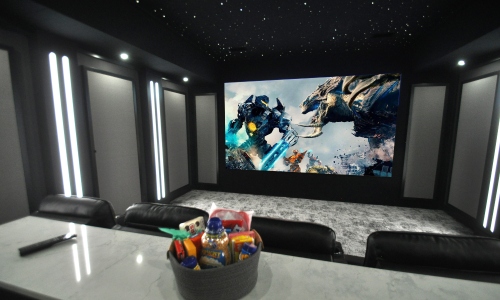For years, particularly during the 1990s and before the advent of flat-screen TVs, homeowners had to endure the painfully bulky and small screen size of CRT televisions with sound that still lacked the expansiveness of commercial theaters for their media rooms. Not only were these earlier home theater systems unflattering to many interior designs, but they also often required a sizable investment from users in equipment and installation services from some elite designers.
By the 2000s and the introduction of flat-screens TVs and digital surround sound formats such as Dolby Digital, and later Dolby TrueHD and DTS-HD Master Audio, homeowners were finally getting a taste of what a home theater system could truly deliver, and the idea of what a modern media room could look like was finally taking shape.
What it Takes to Build a Modern Home Theater System
Now after years—or in fact decades—the average U.S. homeowner is more than capable of enjoying an entertaining home theater system that fits both their budget and their lifestyle, so let’s look into just what it takes to assemble such a solution.
Understanding Display and Projection Options
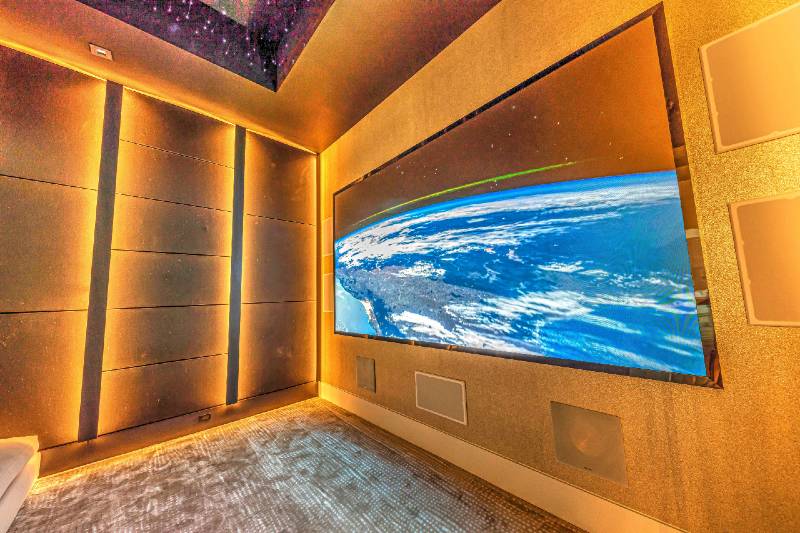
TV screen sizes have gotten a lot bigger compared to what they were a few years ago. According to data from the research firm Statista, from the 10-year period of 2012 to 2022, the size of LCD TV screens in the U.S. increased from 38 inches to 50 inches. Not only that, but the image technology used by TVs has changed drastically as well, with LCD no longer the only option when it comes to selecting a display for your home theater system.
Now in 2024, you can walk into a big-box retail store and buy OLED, QLED and mini-LED TVs as large as 98 inches for a reasonable sum of money, with each type of technology offering their own pros and cons for the home theater enthusiast.
Stepping up into bigger screen sizes, however, there’s very few display technologies that can compete with projection in terms of size and image clarity (when used in a pitch black space). This can range from traditional home theater projection systems with screen sizes ranging from 150 to 200 inches or even bigger to newer solutions like “laser TVs” such as this model from Hisense. This increasingly popular video product category entails an ultra-short throw projector (UST), which can be placed less than a foot from a companion screen to deliver 4K HDR images anywhere in size from 100 to 120 inches.
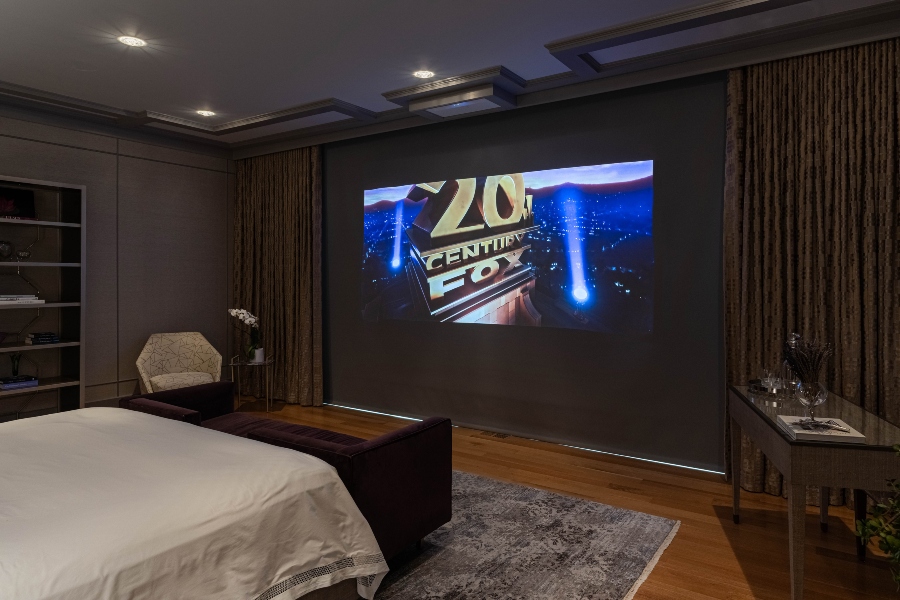
Beyond that there is also what may be the ultimate video on the market right now: microLED. This technology comes from the world of commercial AV, and it utilizes state-of-the-art pixel technologies to produce large, high-quality images in a range of indoor or outdoor environments.
Depending on the choice of products, these solutions can deliver resolutions that include 4K UHD (3840 x 2160) or 8K (7680 x 4320). Some projectors, video-wall displays such as microLED and TVs are also capable of providing HDR (high dynamic range) compatibility. HDR is designed to enhance image quality and some of the most popular HDR formats available include HDR10, HDR10+, Dolby Vision, and Hybrid Log Gamma (HLG). What you want for your home theater system and what you or your client is able to afford is up to you.
What Speakers Are Best Depends on Your Space and Budget
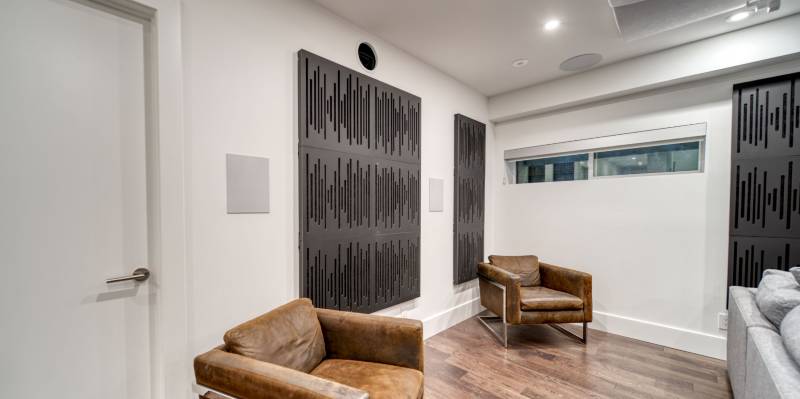
Over in the audio side of the home theater world, processing formats have evolved from the analog Dolby Pro Logic technologies to today’s spatial audio formats—which are more commonly referred to as immersive audio. The most well-known of these home theater formats are Dolby Atmos and DTS:X.
Over the past several years as hardware manufacturers have caught up to the developments in the software and processing sides of the home AV market, manufacturers have been able to design more consumer-friendly solutions that can fit into a wide range of home theater systems and media rooms.
Arguably, the most notable of these affordable solutions are soundbars. Soundbars are available to the public that range from affordable passive designs (passive means the soundbar omits any sort of amplification), to more expensive powered (the term powered or active indicates the soundbar incorporates its own amplification) soundbars that offer Dolby Atmos immersive audio capabilities.
Moving up the pricing ladder from soundbars to more traditional speakers–as well as subwoofers, height speakers, and center-channel speakers–these products are also available at a range of prices to fit into varying home theater system budgets.
One of the benefits of traditional speaker products, along with subwoofers and other in-room, in-wall, and in-ceiling loudspeakers is they also provide homeowners more system flexibility for their media rooms.
Using in-room, in-wall, and in-ceiling loudspeakers homeowners can enjoy surround sound through speaker configurations such as 5.1 (the five indicates the number of speakers and the point one indicates a subwoofer for example) or 7.1 that complement their home décor. Because of the popularity of immersive audio in the world of home theater, more advanced systems are also available.
These configurations include 5.1.2 (the point two indicates the number of height speakers the system employs), as well as 7.1.2, 7.1.4, and even other configurations such as 9.1.2 and more.
Amplification Can Greatly Improve a Theater System’s Sound Quality
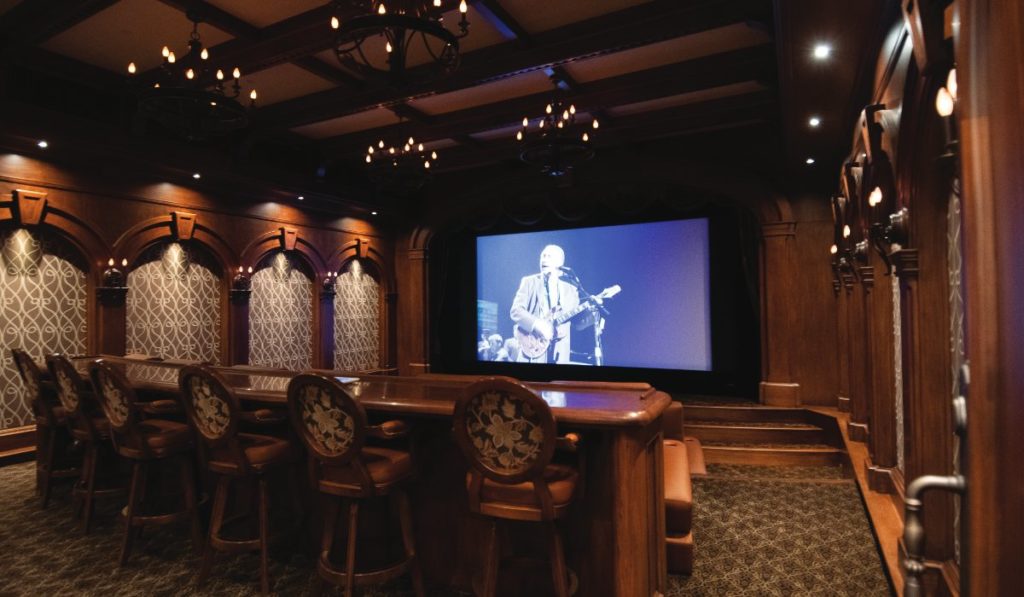
Explaining how homeowners can maximize their investment into an immersive audio/spatial audio system, Joe de Jesus, product manager, PSB Speakers & custom installation at Lenbrook, points out the market offers a host of choices.
When you are building a home theater system, the basic ingredients, according to de Jesus, are any type of TV or projection display and speakers that can then be paired with amplification and processing, especially if you are trying to develop the same type of surround sound or immersive audio experience that you would find going to a commercial cinema.
Variations he continues, include a traditional system with a multichannel audio/video receiver that incorporates amplification powering multiple speakers and the processing to process in homeowners’ preferred format, to soundbars that are paired with wireless subwoofers.
“The early generations of surround sound systems focused on bringing the movie theater experience to the home. Customers could find varying degrees of performance at different price points, but almost all the systems consisted of a receiver or processor/amp combination, wired to several speakers which needed to be placed in specific points in the room, as well as a wired powered subwoofer,” he asserts.
“The biggest obstacle to the home theater experience was not price, but the installation itself. Today’s surround sound systems offer hardware and content capable of producing a much more accurate and refined level of performance for the rooms that can accommodate a textbook solution. But those who are limited by speaker placements or cable runs or space for traditional electronic equipment, are no longer forced to sit on the sidelines.”
Expanding upon his explanation, de Jesus says the baseline that homeowners should target in their home theater system is the highest possible sound quality levels given their budget. To achieve those goals he notes, homeowners should target performance parameters such as the ability to reproduce two-channel (stereo) content with as much accuracy as possible through proper product choices and proper media room designs and furnishings.
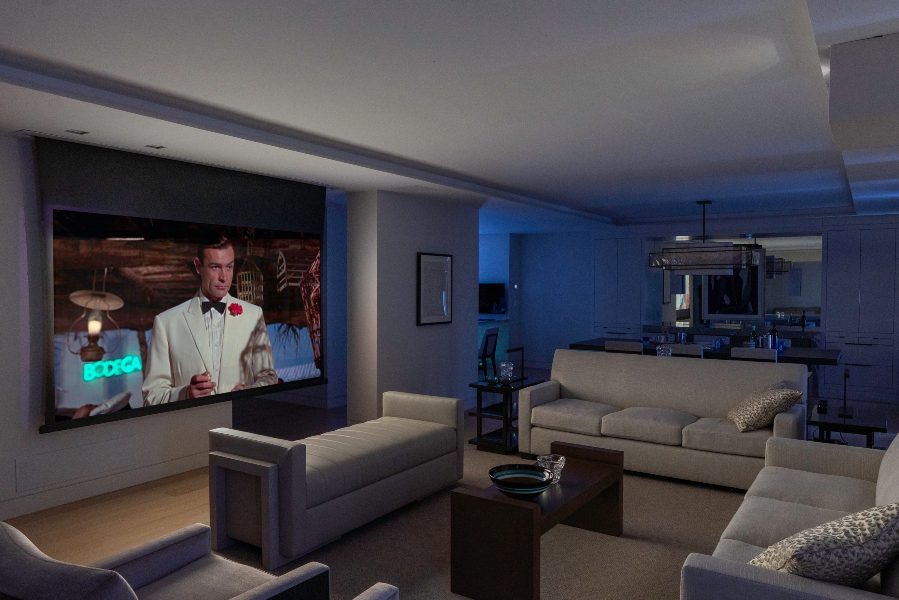
Other attributes that consumers should also consider include the ability of the amplification to reproduce dynamics (quieter, softer moments, to loud, impactful moments), and intelligibility and clarity with content at low and high volumes.
Room Acoustics Will Either Make or Break a Home Theater System
As someone transitions from the baseline values that de Jesus has outlined into more advanced home theater system solutions, de Jesus stresses the impact that room acoustics can have on system performance.
“One of the most important areas of improvement is room calibration. I can’t emphasize enough how important it is to take the time to properly and methodically go through the process,” he says.
“So much of the overall performance is dictated by the characteristics of the room itself. Rooms often have some ugly little acoustic characteristics which can be greatly mitigated by the calibration system.”
Some of the ways that homeowners can approach media room acoustics is through the services of acousticians such as Anthony Grimani and Steve Haas, or more commonly used methods such as room calibration software programs.
Many of the home theater electronics companies offer their own proprietary room calibration EQ (equalization) solutions built into their products. Manufacturers can also license calibration software from companies that include Dirac and Audyssey that consumers can use to tame unrulily acoustics.
The long-time home audio industry veteran adds that regardless of whether someone invests into an entry level type of system or a state-of-the-art immersive audio system, modern surround sound/immersive audio system, these media solutions will provide high levels of fun for kids and adults with TV shows, movies, gaming activities, and music.
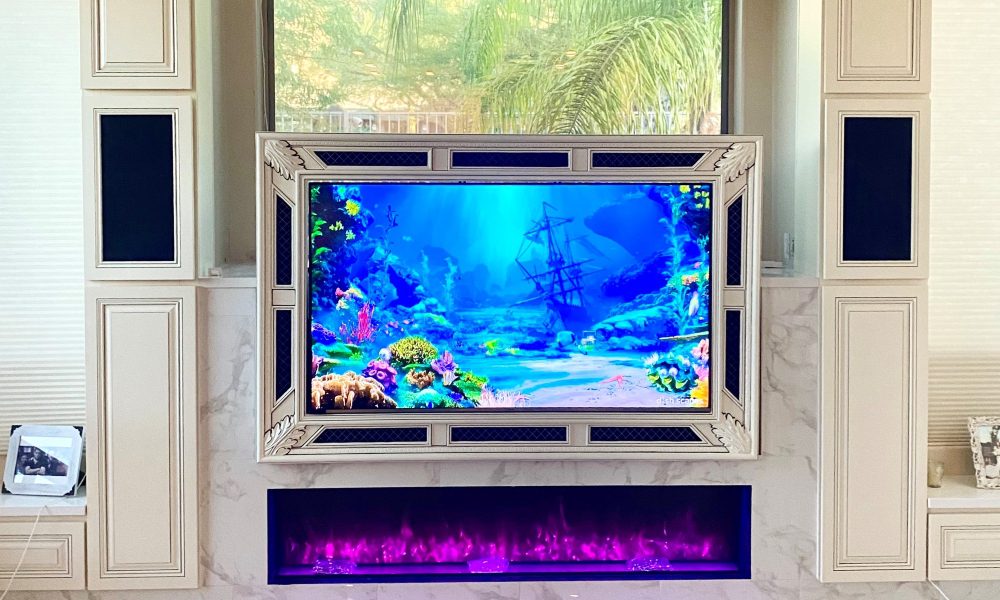
“A well-designed surround system is the kind of thing which needs to be experienced to truly appreciate. I have often described what a system is doing, what to listen for and what to expect. But it is refreshing to see the look of surprise on someone’s face when they hear it for themselves,” enthuses de Jesus.
“The thing which they most comment on, is the sense of perspective. It is the difference between experiencing something which is taking place on stage versus being in the middle of the action. Sporting events are much more engaging when your ears tell you that you are in the stadium. The moment someone has such an experience, the words immersive and 3D suddenly make sense.”
Of course, once you have that home theater system installed, don’t forget to test it out with the right movies to make sure you got everything running perfectly.
Common Home Theater Terms and Definitions:
4K/UHD: The Consumer Technology Association (CTA) defines 4K UHD as a display with a minimum of 8 million pixels with a resolution of 3840 x 2160.
8K/UHD: The CTA says an 8K display must have at least 33 million pixels with a screen resolution of 7680 x 4320.
Aspect Ratio: This term describes the shape of a display or projection screen. The most popular aspect ratio in modern home video is 16:9. In the days of analog television, aspect ratios were 4:3. Movies can be any number of aspect ratios, including 2.35:1, 2.39:1 and 2.40:1.
AV Receiver (AVR): AV receivers are all-in-one components that include amplification, HDMI inputs and outputs to manage audio and video signals, and a wealth of other connections to allow users to play their streaming devices, turntables, CDs and other forms of media.
CinemaScope: This is a term related to the aspect ratios of movies. The term is often used to describe 2.35:1, 2.39:1 and 2.40:1 aspect ratios.
Crossover Network: An electrical network that controls the signals an amplifier sends to a loudspeaker and its respective drivers. A crossover network directs high frequencies to a tweeter and low frequencies to a woofer for example.
Decibel (dB): A measure of loudness or volume level expressed logarithmically.
Dedicated Home Theater System: A space within a home that has a singular purpose of AV entertainment.
DLP: This is a Texas Instrument technology based on the company’s Digital Micromirror Device (DMD) chip technology. DMDs employ small, reflective micromirrors to perform the manipulation of light. DMD is combined with lamp- or laser-based light engines in projectors.
Dolby Atmos: Atmos is a surround sound technology commonly referred to as immersive audio or spatial audio. Atmos places specific sound elements anywhere within the listening field including overhead to deliver a more realistic audio experience.
Dolby Digital: Dolby Digital is a lossy surround sound format that offers an improvement in performance from the company’s analog Dolby Pro Logic formats.
Dolby Digital Plus: Designed as a step-up version of Dolby Digital, the Plus version provides a higher bitrate for better sound and more audio channels.
Dolby Vision: Dolby says Dolby Vision is a video HDR (high dynamic range) technology that optimizes image quality based on factors such as the type of display and the content type.
DTS Master Audio-HD: This is a lossless format that provides multichannel (multiple speakers) surround sound. DTS Master Audio-HD was used in commercial cinemas, and many Blu-ray discs feature the format.
HDMI 2.1: The latest iteration of the HDMI format, 2.1 supports the transmission of 8K signals at 60Hz and 4K video at refresh rates of 120Hz. In total the Ultra High Speed HDMI cable supports up to 48Gbps of throughput to enable features such as eARC (Enhanced Audio Return Channel), immersive audio, including formats such as Dolby Atmos and DTS:X, and CEC (Consumer Electronics Control) to control connected devices such as TVs.
Additionally, the 2.1 format offers gaming support with features such as Variable Refresh Rate that is designed to minimize lag, studder and frame tearing, as well as QMS (Quick Media Switching) that is said to eliminate the delay when frames change refresh rates. It also should be noted HDMI supports HDR (high dynamic range) content.
Height Speaker: A relatively new type of home speaker product, these solutions are designed to reproduce the “height” effects in an immersive audio surround sound system. Often in a home with in-ceiling speakers, integrators will use their favorite in-ceiling speaker models.
For homes with “in-room” speakers or traditional box speakers located within a room, height speakers are modules that can be placed on top of floorstanding speakers or in other locations such as bookshelves. These speakers will fire upwards towards the ceiling, and they are engineered to reflect sound off ceilings to disperse sound in specific patterns to replicate a speaker that is mounted within a ceiling.
High Dynamic Range (HDR): According to the CTA, a display must be able process static HDR metadata such as the HDR10 standard. Since the standard was first adopted the home video market has evolved with the growing acceptance of dynamic HDR formats that include Dolby Vision.
IMAX Enhanced: IMAX explains that IMAX Enhanced is a program that certifies products that meet specific performance standards for viewing mode, resolution, color, brightness, contrast, and audio quality. IMAX Enhanced certified products produce IMAX approved picture levels of quality and DTS immersive surround sound in home environments.
Immersive Audio: Immersive audio is a term used to describe multichannel audio (multiple speakers) that is designed to envelop listeners in a 360-degree sound field. The term is interchangeable with spatial audio, and the most well-known immersive audio format, is Dolby Atmos.
Dolby describes Atmos as object-based surround sound. This description relates to placing “objects” in the sound field rather than assigning a sound to a channel, which is how older formats “mixed” surround sound. This technology allows sound engineers to place sounds over listeners for example with that sound panning across the sound field to recreate the sound of a jet flying.
LCD: Liquid Crystal Display is a flat screen display technology that has evolved over the years. Today, it is a popular television technology.
LCoS: Liquid Crystal on Silicon is a more advanced variant of LCD. Proprietary versions of LCoS include Sony’s SXRD chip technologies and JVC’s D-ILA chip technologies.
LED: Light emitting diodes are a flat screen display technology that are aligned to form displays. LEDs deliver high levels of brightness and color vividness.
Long-Throw Projection: This is the traditional type of projection system that is used in environments that range from commercial classroom settings to commercial theaters.
Lumens: Is a unit of light measurement that is used to quantify the brightness of projectors and it is also used to indicate the brightness capabilities of lighting products.
Midrange Driver: An audio transducer or driver designed to reproduce frequencies located in the middle of the audio spectrum.
Mini-LED: A more advanced version of LED technologies. Mini-LED displays are highlighted by the size of the Mini-LED diodes. Mini-LEDs are smaller than traditional LEDs (but not as small is MicroLED) and because of their size, which enable the use of more Mini-LEDs than traditional LED displays. Mini-LEDs are known for their ability to deliver a greater degree of back panel lighting control to a television to result in improved picture quality.
Multipurpose/multimedia Room: This type of home space houses AV equipment and the room is used for a range of activities such as gaming, movies, sports, reading and other traditional endeavors.
Nits: Is a unit of light measurement that is used to quantify the brightness of TVs, displays and smart devices.
Ohm rating: Used to describe the level of electrical resistance in a circuit. In the case of a loudspeaker, manufacturers use this term to help dealers and consumers safely match an appropriate amplifier to a speaker. It should be noted that a speaker’s ohm rating is often an average rating that is used due to the everchanging resistance a speaker may present.
OLED: Organic Light Emitting Diodes are a flat screen TV technology made from organic materials. OLED technologies were made popular by LG.
Projection Screen: The companion piece of equipment that completes a projection system. There are several different types of projection screen material that are highlighted by matte white, gray and dark finishes. There are also woven and perforated screens that support the ability to place loudspeakers behind the screen to replicate a commercial theater.
Rec. 709: This is a color standard that was developed as part of the high-definition (HD) television standard.
Refresh Rate: Intel defines refresh rate as the number of times a display refreshes an image. The number of times a display is updated is timed in milliseconds and the rate is expressed in Hertz. The higher the number, the smoother and more lifelike a video display will appear.
Sensitivity: A rating used by speaker companies to describe how easily a speaker converts amplifier power into sound. The higher the number means the more easily that speaker could theoretically play in terms of volume when compared to a lower sensitivity speaker.
Separates: A term often associated with higher performing audio components. Separates include audio preamplifiers, audio processors and audio amplifiers. The premise is that stand-alone components like an amp and preamp perform better than an AV receiver.
Sound Pressure Level (SPL): A term that indicates volume level using decibels. SPL meters are used to measure sound volume.
Subwoofer: A specific type of speaker that is engineered to reproduce low frequencies. Subwoofers are a dedicated solution, and many manufacturers will recommend that subwoofers work better to reproduce bass frequencies in pairs or even groups of four total subwoofers.
Surround Sound: Surround sound expands on the sound capabilities of traditional stereo audio by adding more speakers (channels). Popular surround sound audio formats include Dolby TrueHD, Dolby Pro Logic, and DTS HD-Master Audio. Modern surround sound also includes immersive audio formats such as Dolby Atmos and DTS:X.
THX: Initially developed by Lucas Films as a set of performance standards that includes a certification program for home AV components. Today, THX is a stand-alone company. Products with THX certification have been thoroughly tested to ensure they meet these stringent standards.
Tweeter: An audio transducer or driver designed to reproduce high frequencies.
Ultra-Short Throw: A type of projection product that employs technologies that include specific types of lenses that allow for the placement of projectors small distances from projection screens.
Upscaling: Refers to a technology that adds resolution to video content. For example, an HD video signal at 1920 x 1080 may be upgraded or upscaled to 3840 x 2160 or UHD/4K.
Video Calibration: Calibration refers to setting up a home video system to accepted specifications that are designed to maximize performance and the user experience. Some of these specifications includes image brightness, image contrast, and color accuracy.
Watts Per Channel (WPC): A term for audio amplifier power. The Consumer Technology Association (CTA) provides specific criteria for manufacturers to follow to help consumers find accurate power rating specifications.
Wide Color Gamut: The Consumer Technology Association (CTA) says a display must be compliant with ITU-R BT.2020 signals, as well as having the ability to process the Rec. 709 color space standard. The BT.2020 color space is a next-generation color specification that offers a wider array of colors than Rec. 709.
Woofer: An audio transducer or driver within a speaker designed to reproduce lower frequencies.
